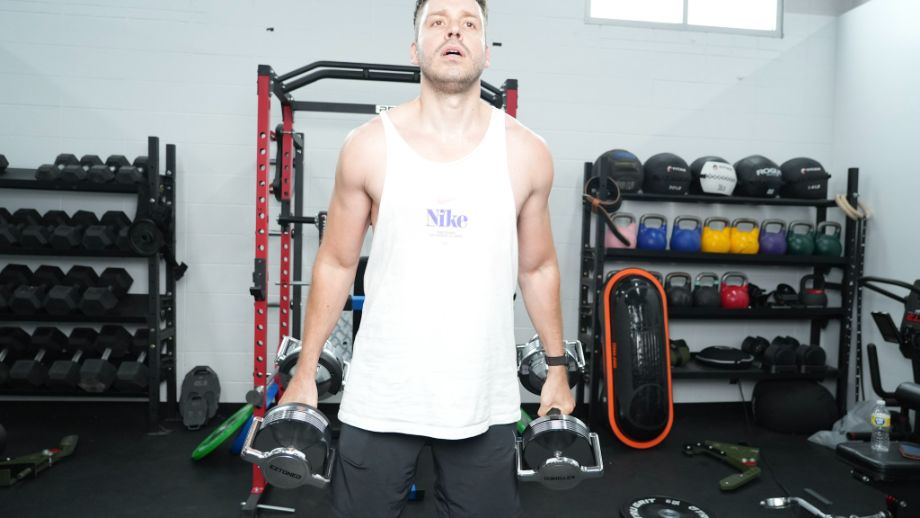We test and review fitness products based on an independent, multi-point methodology. If you use our links to purchase something, we may earn a commission. Read our disclosures.
Old MacDonald had a walk and ee-i-ee-i-oh, man, was it one heck of a workout!
Once reserved for strongman athletes, the farmers’ walk exercise has become increasingly popular in recent years, finding its way into various types of strength training programs from boutique fitness studios to CrossFit boxes to home gyms.
And, when you consider how much bang you get for your buck, it makes total sense!
Farmers’ walk benefits are seemingly endless, ranging from improved core strength and stability, increased grip strength, enhanced muscle endurance, and greater aerobic capacity.
Plus, they’re super convenient. All you need are a pair of the best dumbbells, a small stretch of space to walk around, and you’re good to go!
If you’re ready to find out more about the farmers’ walk, its benefits, and how you can add it into your workout routine, read on!
Medical disclaimer: This article is intended for educational and informational purposes only. It is not intended as a substitute for medical advice. For health advice, contact a licensed healthcare provider.
What Is a Farmers’ Walk?
As the name suggests, the farmers’ walk is an exercise meant to imitate the movements and techniques employed by farmers when carrying heavy objects across a long distance. While farmers are apt to carry farm-related items, like tools or bales of hay, we simulate the experience using free weights (and it’s up to you if you’d use dumbbells vs kettlebells).
The farmers’ walk provides excellent activation throughout many major muscle groups, including the arm and back muscles of the upper body, the leg muscles of the lower body, and, of course, the core muscles smack dab in the middle.
Given this, the farmers’ walk is a highly effective compound exercise, making it great to include in any and every comprehensive strength training program.
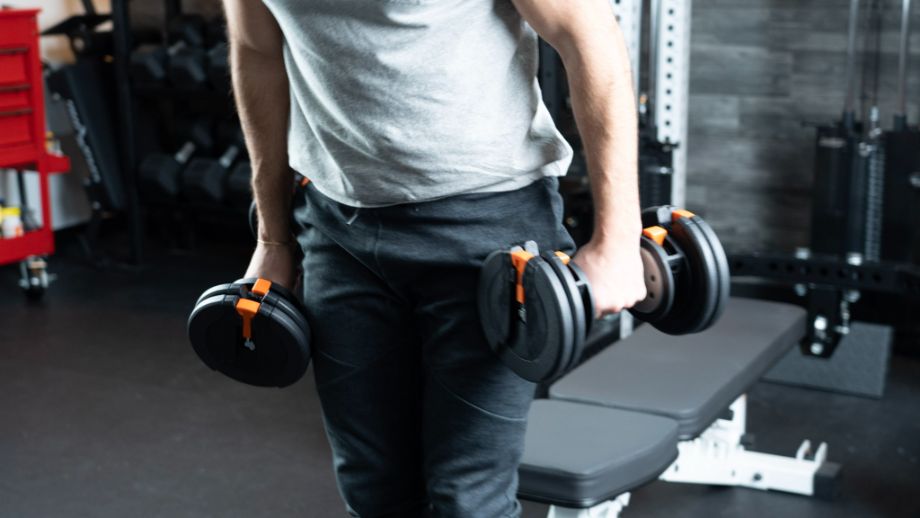
Farmers’ Walk vs Farmers’ Carry vs Farmers’ Hold
The terms farmers’ walk, farmers’ carry, and farmers’ hold are often used interchangeably, but it’s not entirely correct.
The farmers’ hold makes no specific mention of walking or carrying anything, so performing a farmers’ hold is as simple as grabbing two dumbbells, or any other free weight, and standing there. Unlike the walk or carry variant, the hold is an isometric exercise, similar to exercises such as the plank or L-sit.
The farmers’ walk and farmers’ carry, on the other hand, are more or less the same thing, so it’s fair to use these terms interchangeably. Both refer to performing a farmers’ hold while walking.
Farmers’ Walk Benefits
The farmers’ walk boasts many benefits. They’re easy to perform and require very little equipment, making them beginner-friendly, versatile, and perfect for home gym setups.
There are also many health and fitness benefits of the farmers’ walk, too.
Works Many Muscle Groups
The simple act of picking up heavy weights and walking around with them provides incredible activation throughout the whole body, especially the core and the lower body.
In fact, the Journal of Human Kinetics1, following a 2015 study that examined electromyography amplitude during the farmers’ walk exercise, stated, “The farmers’ walk exercise should be used as an exercise to strengthen the [gluteus medius], especially in groups with a [hip abductor muscle] weakness.”
Additional muscles worked during the farmers’ walk include:
- Core: Holding heavy weight steady requires a strong, stable core and strong muscles in your abdomen and lower back. That includes the rectus abdominis, obliques, and erector spinae.
- Legs: Walking in general activates muscles like the quadriceps, hamstrings, glutes, and calves, but you’ll get a more pronounced effect thanks to the heavy weights you’re carting around.
- Shoulders: Holding onto weights engages the muscles of the shoulders and upper back, including the deltoids, trapezius, and rhomboids, allowing you to keep a strong, tall posture as you move. The lats also are recruiting, helping you maintain good posture and neutral spine alignment.
- Arms: From shoulder to wrist, your arms will get a lot of activation while holding and carrying the weights. Your forearms are probably most crucial, as they’re most responsible for helping you keep a grip on the weight. However, your biceps, responsible for arm flexion, and your triceps, responsible for arm extension, provide support and stability to the elbow joint while also helping you keep a strong grip.
RELATED: The Best Core Exercises Equipment
From head to toe, you’ll receive ample activation throughout many major muscle groups while performing farmers’ walks.
Improves Core Strength
Of course, all-around strength is a worthy pursuit, but there are some great benefits associated with core strengthening alone.
According to the American Journal of Sports Medicine2, following a randomized controlled trial published in 2021, “core strength training” that includes exercises like the farmers’ walk “might be considered in ACL injury prevention” based on how this kind of training “[alters] the motor control strategies and joint kinematics for the trunk and the lower [extremities].”
According to the Journal of Physical Therapy Science3, “core strength training is more effective than typical resistance training for alleviating chronic low back pain” as well.
Since the farmers’ walk provides activation to your core muscles, most people see improvements in their core strength and enjoy benefits such as these after implementing the exercise into their regular routine.
RELATED: The 12 Best Ab Exercises To Build Core Strength
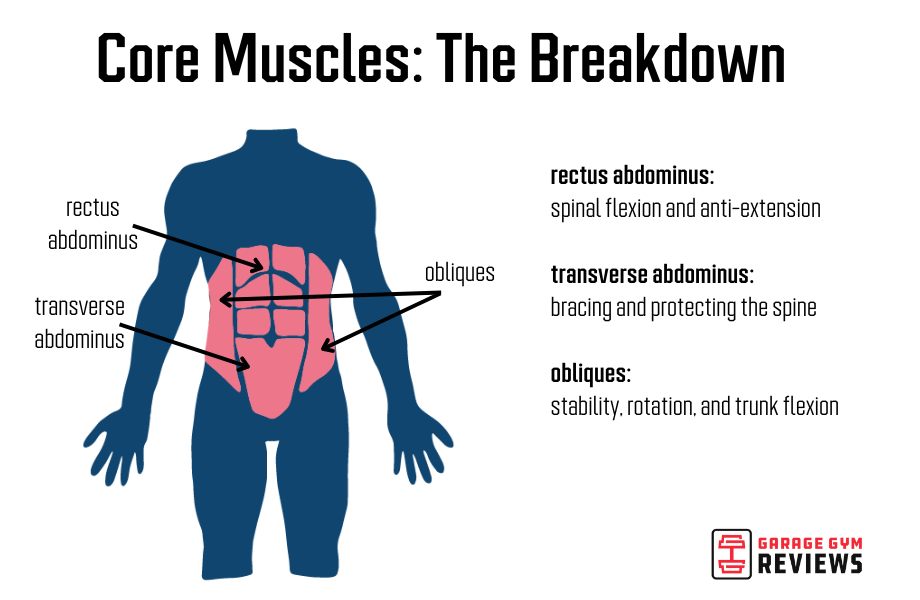
Trains Core Stability
Farmers’ walk, farmers’ carry, and farmers’ hold aren’t the only terms people are swapping around indiscriminately; many people also use the terms “core strength” and “core stability” interchangeably as well.
This is incorrect. We turn to certified personal trainer and GGR Head of Content Kate Meier for information regarding the distinction.
“Core strength is what creates force and power during exercise,” says Kate, “while core stability involves keeping everything in alignment during the movement.”
Think of the body like a race car. For that vehicle to go careening around the track at breakneck speeds, it needs a powerful motor to propel it forward. That’s our sub-in here for strength.
Stability, on the other hand, is the vehicle’s body and chassis. Imagine how well that race car and its impressive engine would perform with the frame of a clunker. Without a stable body to hold things in place, the strength and power threaten to damage the vehicle, and we don’t want that.
Circling back to what this means for exercise and your core, we need both strength and stability to ensure good power output, proper form and alignment, and, as a result, minimal risk of injury, even when the weights get heavy and the movements become challenging.
Strength is nothing without stability, too.
Teaches You How to Brace
Holding tension in your core is natural during the farmers’ walk.
On other lifts and exercises, including squats, deadlift variations, and push-ups, bracing your core is also important, but less intuitive. You may neglect it altogether unless you practice the technique specifically and build muscle memory.
That’s why the farmers’ walk is a great way to practice bracing your core, so you’ll have the knowledge and technique for other lifts and exercises when you need it most.
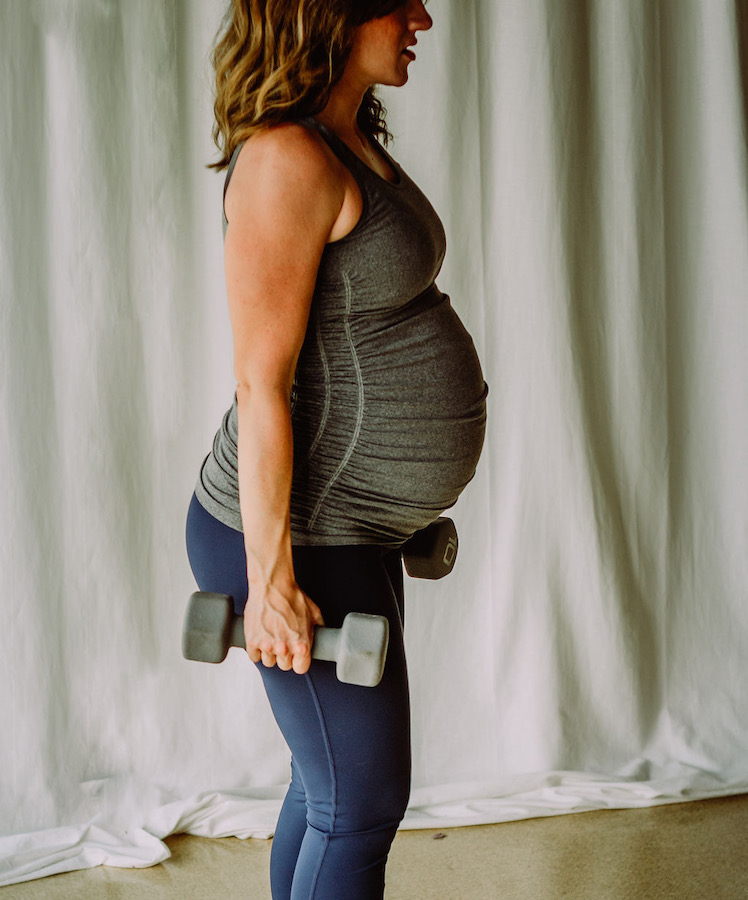
Improves Grip Strength
Practice makes perfect, and what is a farmers’ walk if not excellent practice for holding a heavy weight until your grip is exhausted? Over time, you will become accustomed to holding heavier weights for longer periods of time as a result.
The improved grip strength will be super useful for athletic feats, like completing an extremely heavy deadlift or climbing a technical bouldering route, but regular folks will appreciate it, too, when they’re able to open obnoxiously tight jar lids and perform other everyday tasks associated with grip strength.
Increases Postural Awareness
Our parents and teachers harp about good posture when we’re kids, but it’s about so much more than just looking proper and attentive.
“Good posture and proper alignment are key,” says Kate. “When everything is aligned, the body experiences less stress to its tissues and joints and produces force more efficiently.”
The problem is we don’t always realize when we’re guilty of poor posture unless we consciously check in with ourselves.
A 2018 study published in the BioMed Central Musculoskeletal Disorders4 journal defines this as “postural awareness” or “the subjective conscious awareness of body posture that is mainly based on proprioceptive feedback from the body periphery to the central nervous system.”
The study examined the relation of postural awareness to patients with chronic pain, determining that “improvements in postural awareness are longitudinally associated with reduced pain in patients.”
Because the farmers’ walk requires holding an upright position to stabilize the weights and combat gravity’s effect, you will strengthen your posture and subsequently improve your postural awareness by performing this exercise.
Now that’s a posture your parents can be proud of!
Teaches You to Breathe Under Loads
Many beginners and fitness amateurs have a habit of holding their breath when heavily exerting themselves. Holding your breath is good, in some cases, but it’s expressly not recommended unless you very much know when to hold breath and when to exhale. A personal trainer can help instruct you how and when to do this.
For this rest of your exercises and lifts, make sure you’re breathing through the effort. Since farmers’ walks take much more time than a single rep of, say, the back squat, deadlift, or bench press, it’s very difficult or impossible to hold your breath throughout the exercise.
In that regard, the farmers’ walk helps remind you to breathe while performing a loaded carry.
RELATED: Five Common Lifting Mistakes And How To Fix Them
Develops Pulling Strength
The incredible activation you’ll enjoy in your arms, legs, and core will translate to other activities, especially pulling.
This is all thanks to the activation in the biceps, triceps, and forearms, all of which will allow you to maintain a powerful grip during future pulling exercises, and activation in the core, which will assist in stabilizing the trunk and torso when pulling heavy objects towards your body.
How to Do a Farmers’ Walk
- Select a pair of dumbbells, kettlebells, or heavy bags and hold one in each hand.
- Stand with your feet shoulder-width apart, your arms straight down at your sides, your core tight, and your shoulders down and back with the shoulder blades pinched.
- Walk forward in a straight line. Take short, deliberate steps rather than rushing.
- Continue walking for a predetermined distance or time, then slowly place down the weights and rest.
- Repeat as needed.
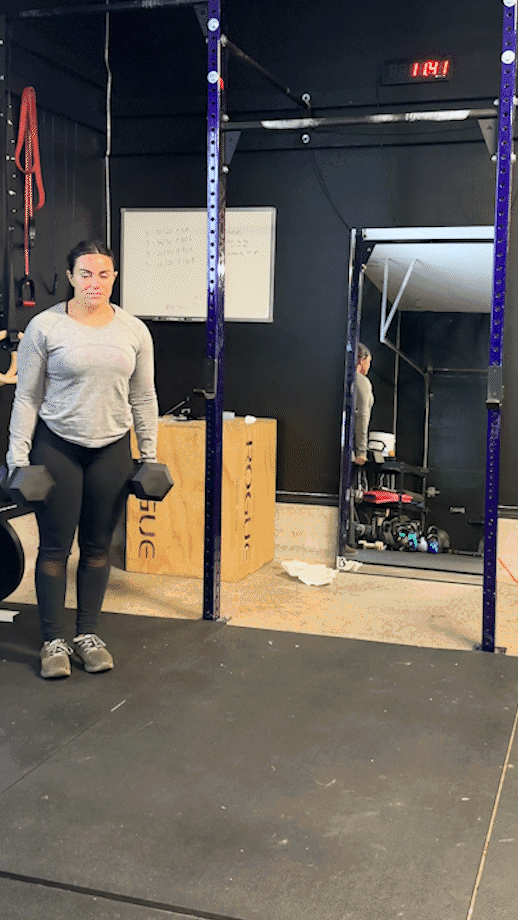
Farmers’ Walk Variations
The general idea behind the farmers’ walk is that you’re grabbing something heavy and walking it across the room. Because it’s so simple, there are many farmers’ carry variations that either alter the stimulus slightly or add an additional challenge.
Single-Side Farmers’ Walk
Some people also refer to this as a suitcase carry. Many bilateral exercises can be performed unilaterally, helping you really hone in on each side independently and correct muscular imbalances. The farmers’ walk is no exception.
A one-armed farmers’ walk requires more core stability and better balance than its two-armed counterpart, but it’s an interesting alternative when you’re looking to switch things up.
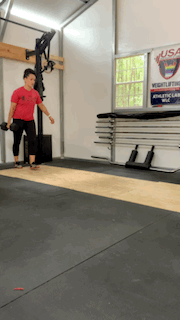
Trap Bar Farmers’ Walk
Another interesting way to tackle your farmers’ walk is to use a trap bar. Because of the trap bar’s unique shape and inherent stability, this variation puts less strain on the lower back and often allows you to lift heavier weights than possible using dumbbells or kettlebells.
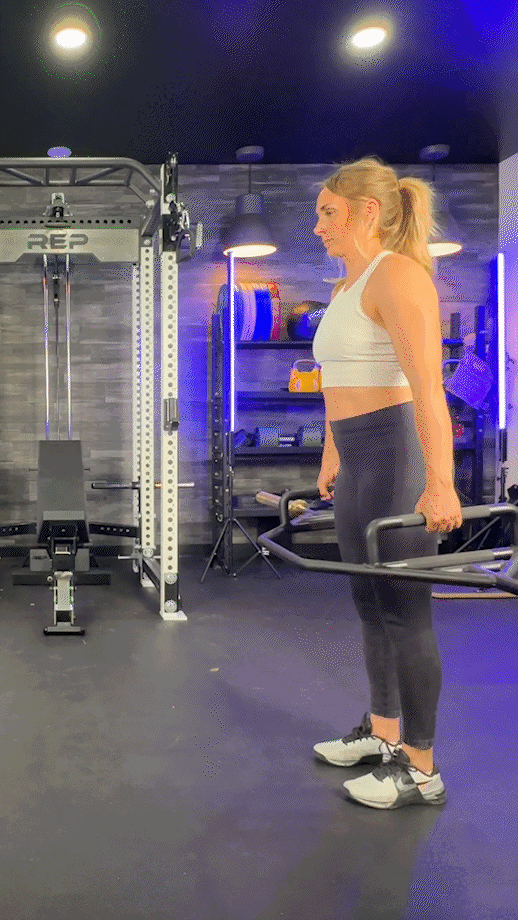
Odd Object Carry
No free weights to speak of? No problem!
Making use of common household items like water jugs, laundry detergent, a duffel bag—the possibilities are endless!
Buckets of water make an interesting choice. As you walk, the water in the bucket sloshes back and forth, requiring you to exercise great core stability and make constant adjustments in order to keep it from spilling out.
We also love using sandbags, as you get to practice a pinch grip instead of the standard crush grip you’re more often using on Olympic barbells and other free weights.
Barbell Farmers’ Walk
Could you imagine grabbing two barbells like suitcases and carting them across the gym floor for your farmers’ walk?
With a great pair of farmers’ walk handles, you can!
Farmers’ walk handles make use of perfectly good barbells you may already own and allows you to put a suitcase handle on the bar, making farmers’ walks using barbells much more manageable. They make an excellent buy if you already have a barbell and weight plates at home but own no dumbbells.
Farmers’ Walk Benefits: Final Thoughts
When it comes to full-body exercises that build core strength, grip strength, endurance, and provide a cardio workout to boot, the farmers’ walk checks all the boxes, making it an easy “one stop shop” for improving your fitness in a variety of ways.
Whether you’re looking for a core builder outside of good ol’ crunches or you’re in need of the perfect finisher exercise that will provide improvements to your overall body strength head to toe, you’ve found it in the farmers’ walk.
Pick up some free weights and walk your way to better health by working the farmers’ walk into your next workout! Good luck, fitness fam!
Farmers’ Walk Benefits: FAQs
How long should you farmers’ walk?
How long you should try to farmers’ walk depends on your current fitness level, personal goals, and the weight you’re carrying.
Beginners should always start small, completing no more than 60 seconds or 100 feet at a time. Move slowly, listen to your body, and take breaks as needed.
As you find yourself getting more comfortable with the weight and the form, increase the length of the timer or scale up to progressively heavier weights.
For personalized advice, consult a certified personal trainer or qualified coach. They will observe your form firsthand and make recommendations specific to you.
Is it good to do a farmers’ walk every day?
We love the farmers’ walk, but targeting the same muscle groups daily is a recipe for overtraining, injury, and burnout.
You need to give your body adequate time to recover in between bouts of exercise.
The most common ways to recover include taking rest days between sessions or rotating the targeted muscle groups each day.
If you’re performing farmers’ walks daily, you’re doing neither. For this reason, we don’t think it’s wise to do farmers’ walks every day, but a few times a week should be okay.
What are farmers’ walks good for?
Farmers’ walks offer a wide variety of fitness benefits, including:
– Building strength
– Increasing muscle mass
– Improving grip strength
– Improving cardiovascular health
– Enhancing muscle endurance
– Encouraging good posture
– Providing a low-impact workout
Farmers’ walks are also easy to learn, beginner-friendly, versatile, and require very little equipment to perform. They’re an overall excellent tool to incorporate into any workout routine.
What muscles do farmers’ walks work?
Short answer: everything!
The farmers’ walk predominantly targets your core and leg muscles, but you’ll also get plenty of activation in the upper body including the shoulders, back, and arms.
References
1. Stastny P, Lehnert M, Zaatar A, Svoboda Z, Xaverova Z, Pietraszewski P. The Gluteus Medius Vs. Thigh Muscles Strength Ratio and Their Relation to Electromyography Amplitude During a Farmers’ Walk Exercise. J Hum Kinet. 2015;45:157-165. Published 2015 Apr 7. doi:10.1515/hukin-2015-0016
2. Jeong J, Choi DH, Shin CS. Core Strength Training Can Alter Neuromuscular and Biomechanical Risk Factors for Anterior Cruciate Ligament Injury. Am J Sports Med. 2021;49(1):183-192. doi:10.1177/0363546520972990
3. Chang WD, Lin HY, Lai PT. Core strength training for patients with chronic low back pain. J Phys Ther Sci. 2015;27(3):619-622. doi:10.1589/jpts.27.619
4. Cramer H, Mehling WE, Saha FJ, Dobos G, Lauche R. Postural awareness and its relation to pain: validation of an innovative instrument measuring awareness of body posture in patients with chronic pain. BMC Musculoskelet Disord. 2018;19(1):109. Published 2018 Apr 6. doi:10.1186/s12891-018-2031-9
Further reading

Walking and jogging backwards on the treadmill is not only safe, but it can be beneficial to your joints, increases muscle strength, and improves coordination. Read more

If you’re reading this, I assume you’re probably pretty familiar with the brand Kabuki Strength. In the past few years, they’ve put out some of my favorite products including the versatile Trap Bar, Transformer Bar V4, and New Generation Power Bar. Kabuki recently released a flywheel, and I’ve been itching to try it.In this Kabuki Kratos Flywheel review, I’ll walk you through what’s included, unique aspects of this product, and my final thoughts. As always, I’ll give you all the details you need to make a smart buying decision for you.For those of you who aren’t familiar with flywheel training, it can be an effective way to build strength within your body’s connective tissue. It can also increase overall power, muscle hypertrophy, and force.Essentially, it’s useful for eccentric overload training where the muscle is stretched during both the lifting and lowering of your reps. The resistance is inertia driven, which means it is all based on how much force the user puts into the movement with the flywheel. Read more

Are these dumbbells already the best in the industry? Find out in our REP x PÉPIN Fast Series Adjustable Dumbbell Review. Read more

Our sauna maintenance tips will help you maintain a clean, safe sauna for years to come. Read more

